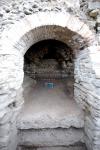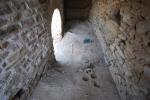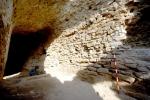Summary (English)
The Roman theatre at Stobi is a building with long history of excavations starting in 1924 with the campaigns of Balduin Saria. Beside the first investigations, significant projects are the excavations in the 1970s directed by Elizabeth R. Gebhard and the new systematic excavations of NI Stobi led by Goce Pavlovski, initiated in 2009 and still ongoing. The realization of a conservation project for the theatre begun in 2013.
The excavations in 2014 were conducted in the eastern half of the central circular corridor and in the ima cavea segment of the eastern radial corridor. The circular corridor is 2.5 metres wide, around 6 metres high and the excavated half is around 40 metres long. The campaign lasted four months. The results include a level of abandonment of the theatre from the end of the 4th century and series of floor levels with three screen walls from the 5th and 6th centuries
Given the results from the excavations in 2013, it can be concluded that the corridor was continuously occupied since the moment when the theatre went out of use at the end of the 4th century, through the 5th and the 6th century, until the 12-14th centuries. Due to the lack of chronologically sensitive material it remains unknown if there was a gap between the end of the 6th and the 12th century. A context of abandonment was documented in the eastern radial corridor in the form of a steep level of use with traces of burning and layers of ash. As part of the same context, a coin hoard of 70 bronze coins was found in scaffolding hole. The coins have not been cleaned and judging by some better preserved samples they date from the end of the 4th century. Probably towards the end of the 5th or during the 6th century, the slope was leveled with a fill and the corridor was included in the new houses built on top of the theatre.
The walls of the circular corridor were exposed to the height of 3 metres and there are 1-2 metres left to be excavated to the levels of construction and use of the theatre. The walls reveal two types of masonry. The lower one bears traces of red lines used as markers during the construction process. These lines are identical with the red lines and the red Roman numerals documented on the radial walls of the ima cavea in 2012.
The excavations in 2014, also revealed the surface of the preserved remains from the eastern analemma making visible the changes that occurred during the alteration of the architectural concept of the theatre from a western model into a building similar to the Roman theatres of Asia Minor.
- Goce Pavlovski - NI Stobi
Director
- Silvana Blazevska - National Institution Stobi
Team
- Ilija Boshkovski
- Rade Atanasov
- Philip Vitanov
Research Body
- National Institution Stobi
Funding Body
- Ministry of Culture of Republic of Macedonia






![Download [PDF]](/excavation/skins/fasti/images/results/download_sml.png)

